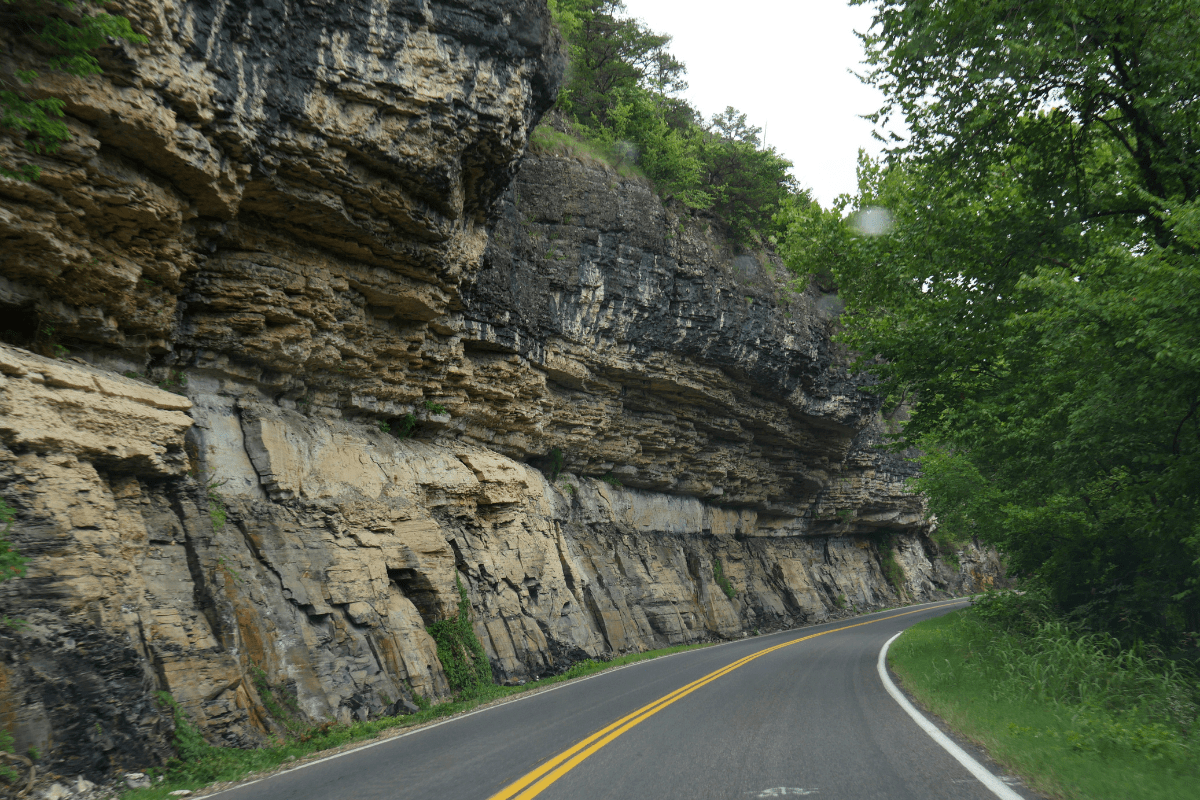If you're sitting in Tulsa on a Friday afternoon, scrolling your phone, wondering if there's anything actually exciting within driving distance that won't eat up your entire weekend in transit… there's good news. Oklahoma and the surrounding area pack way more punch than most people realize, with everything from 500-year-old forests to world-class art museums hiding within two hours of downtown.
Your backyard is more interesting than you think
I used to think you had to drive to Colorado or Nashville for a decent weekend trip, but honestly, some of the best adventures I've had started right here in Green Country. Within 30 minutes of Tulsa, you can be floating on a massive lake, hiking through ancient forests, or getting your adrenaline fix on zip lines that most locals don't even know exist.
The 20-minute escapes that feel like vacation
Keystone State Park sits just 20 minutes west of downtown, and I'm always surprised by how many Tulsans have never been there. This place sprawls across 23,560 acres with three full-service marinas, sandy beaches that actually feel beachy, and some of the best striped bass fishing in Oklahoma. The best part? Day use is completely free, though camping will run you $12 to $23 per night if you want to make a weekend of it.
Right next door is the Keystone Ancient Forest, where 500-year-old cedar trees make you feel like you've stumbled into Middle Earth. I'm not exaggerating when I say some of these trees were saplings when Columbus was still trying to convince people the world wasn't flat. The forest connects directly to the state park, so you can easily do both in one trip.
If you're looking for something completely different, PostOak Zip Line Canopy Tours operates just seven miles northwest of downtown. For $85 during the week or $95 on weekends, you'll spend three hours soaring 50 feet above the forest canopy on over 4,000 feet of cable lines. The aerial views of the Tulsa skyline are honestly pretty spectacular, and it's one of those experiences that makes you feel like a tourist in your own city.
The Route 66 icon everyone photographs
You've probably seen pictures of the Blue Whale of Catoosa on Instagram without realizing it's 15 minutes from Tulsa. This 80-foot-long smiling whale was built in 1972 as an anniversary gift, and it's become the most photographed roadside attraction in Oklahoma. The whole thing is completely free, you can climb inside the whale's mouth for the classic photo, and the nearby Arrowood Trading Post has that authentic 1950s roadside charm that's getting harder to find.
Small towns with surprisingly big attractions
Here's where Oklahoma really starts to surprise people. These aren't sleepy farm towns with nothing to do… they're destinations that draw visitors from across the country.
Pawhuska: The Pioneer Woman effect
Pawhuska transformed from a quiet Osage Nation capital into a legitimate tourist destination, and it's kind of wild to witness. The 25,000-square-foot Mercantile serves up to 3,000 guests daily during peak season, with over 6,000 people visiting the town every single day. That's more daily visitors than some major attractions get.
The famous Cattlemen's Breakfast features a 12-ounce ribeye with eggs that'll definitely cure any hangover, and various pancake options have become Instagram sensations. But honestly, the most impressive part isn't Ree Drummond's empire… it's the Osage Nation Museum, which happens to be America's oldest tribally-owned museum, founded in 1938. The recent connection to Martin Scorsese's "Killers of the Flower Moon" has added another layer of historical significance.
Don't miss the Tallgrass Prairie Preserve, where 2,500 free-ranging bison roam across 40,000 acres. Seeing these massive animals in their natural habitat is genuinely moving, especially when you consider how close we came to losing them entirely.
Bartlesville: Oil money built some cool stuff
Bartlesville sits 45 miles north and showcases what oil boom money could accomplish when people had vision. The crown jewel is supposed to be Frank Lloyd Wright's Price Tower, his only realized skyscraper, though it's currently closed during an ownership transition. The real star is Woolaroc Museum & Wildlife Preserve, which sprawls across 3,700 acres with a 50,000-square-foot museum housing one of the finest collections of Western art and Native American artifacts in the world.
Frank Phillips, the Phillips Petroleum founder, established this retreat in 1925, and the bison herd he started still roams the preserve today. Families absolutely love Kiddie Park, where 16 carnival rides cost just 50 cents each. It's like stepping back into the 1950s, when everything was simpler and way cheaper.
Tahlequah: Cherokee heritage and river fun
Tahlequah has been the Cherokee Nation capital since 1838, and the cultural experiences here are profound. The Cherokee National History Museum occupies 7,000 square feet in the original Cherokee Capitol building, which reopened in 2019 after extensive renovations. The 1844 Cherokee National Supreme Court Museum showcases Cherokee language exhibits that help visitors understand the complexity of this sovereign nation.
Beyond the cultural sites, the Illinois River provides excellent floating, kayaking, and fishing opportunities. It's an ideal blend of education and recreation, especially if you time your visit for the Cherokee National Holiday in late August.
Planning your cultural tour
If you're trying to hit multiple small towns in one weekend:
- Day trips work best
- Pawhuska gets crowded weekends
- Bartlesville pairs well with drive
- Tahlequah needs full day minimum
- Book Mercantile reservations ahead
Natural areas that'll make you forget you're in Oklahoma
Oklahoma's landscape diversity genuinely surprises people who think the whole state is flat farmland. Within two hours of Tulsa, you can experience waterfalls, ancient forests, massive lakes, and even some legitimate mountains.
Natural Falls: Oklahoma's hidden waterfall
Natural Falls State Park delivers one of Oklahoma's tallest waterfalls at 77 feet, located just 1 hour 20 minutes northeast near the Arkansas border. The $10 vehicle entry fee ($8 for Oklahoma residents) provides access to 4.5 miles of hiking trails, an 18-hole disc golf course, and the waterfall that was featured in the 1974 film "Where the Red Fern Grows."
The park maintains luxury yurts that sleep 4-6 guests for overnight stays, offering a unique glamping experience in the Ozark Highlands ecosystem where 18 varieties of ferns thrive in the moist microclimate. It's honestly beautiful year-round, but especially spectacular after heavy rains when the waterfall is at full power.
Grand Lake: Oklahoma's water sports paradise
Grand Lake O' the Cherokees spans 46,500 surface acres with 1,300 miles of shoreline, sitting 1 to 1.5 hours northeast of Tulsa. This ranks as Oklahoma's premier water sports destination, encompassing multiple state park areas including Bernice State Park, known as the "Crappie Capital of the World."
The lake offers everything from parasailing to scuba diving in surprisingly crystal-clear waters. Below Pensacola Dam, eagle watching peaks from October through March, with the Grand River Dam Authority Ecosystems Center providing educational programs about the region's wildlife.
Robbers Cave: Where outlaws once hid
Robbers Cave State Park sits exactly two hours southeast in the Sans Bois Mountains, and this historic outlaw hideout where Jesse James and Belle Starr once evaded capture now welcomes families and adventure seekers. The park offers 20+ miles of hiking trails, popular rock climbing on sandstone cliffs, and 70+ miles of equestrian trails.
Three lakes provide trout fishing (seasonal), swimming beaches, and paddle boat rentals, while the Belle Starr View Lodge and 26 cabins offer comfortable overnight accommodations starting at just $16 per night for backcountry camping.
The art destination that rivals major cities
I'll be honest… I was skeptical about driving to Arkansas for a museum until I actually went to Crystal Bridges. This place legitimately rivals museums in New York or Chicago, and it's free.
Crystal Bridges Museum: World-class art in unexpected Arkansas
Located in Bentonville, Arkansas, 114 miles from Tulsa (about 1 hour 45 minutes), Crystal Bridges Museum of American Art houses masterworks from colonial times to contemporary in architecture designed by Moshe Safdie that literally seems to float above natural springs. The permanent collection includes works by Warhol, Rockwell, O'Keeffe, and Hopper, with free general admission making elite art accessible to everyone.
The museum's 120-acre grounds feature five miles of trails dotted with sculptures, including James Turrell's skyspace installation that transforms sunset viewing into meditation. The Momentary, Crystal Bridges' contemporary art satellite space, adds cutting-edge exhibitions and performances to the cultural mix.
Bentonville itself has undergone a remarkable transformation, with the downtown square hosting the Walmart Museum (also free), local breweries, and one of the nation's most extensive urban mountain bike trail systems. Combined with nearby Fayetteville's University of Arkansas campus, the region offers sophisticated weekend experiences typically associated with much larger metropolitan areas.
Budget smart, explore more
Weekend trips from Tulsa typically cost $200 to $400 for budget-conscious couples or $400 to $600 for those seeking mid-range comfort over two nights. Gas expenses average $20 to $50 roundtrip depending on destination, with Oklahoma's average gas price of $2.70 per gallon remaining below the national average.
Accommodation costs that won't break the bank
- Budget hotels: $69/night average
- Mid-range properties: $99-110/night
- Luxury accommodations: $143/night
- State park camping: $12-23/night
- Cabins starting around $60/night
Many state parks offer camping from $12 to $23 per night or cabins starting around $60, providing affordable alternatives to traditional lodging.
When to go for the best experience
The optimal seasons for weekend adventures are April through May and September through October, when temperatures range from 60 to 80°F and outdoor activities become most enjoyable. Spring brings wildflowers and azalea blooms but also tornado season risk, particularly in May. Summer temperatures reach 90 to 95°F, making water activities at the region's numerous lakes particularly appealing.
Fall delivers spectacular foliage, especially along the Talimena Scenic Byway in southeastern Oklahoma, where 54 miles of mountain road climb to 2,600-foot elevations. Winter offers the quietest park experiences and lowest accommodation rates, though some facilities operate on reduced schedules.
State park entry fees are standardized at $10 per vehicle for out-of-state visitors or $8 for Oklahoma residents, with veterans and Oklahoma seniors over 62 entering free. Annual passes at $60 for residents or $75 for non-residents cover all 22 fee-charging state parks, paying for themselves in just eight visits.
Hidden gems for the adventurous
Spiro Mounds: Oklahoma's archaeological treasure
Spiro Mounds Archaeological Center, 1.5 hours southeast of Tulsa, represents Oklahoma's only prehistoric archaeological site open to the public. Often called the "King Tut of the Arkansas Valley," this sophisticated Mississippian culture site features ancient burial mounds and a museum explaining the complex society that flourished here between 850 and 1450 AD. The guided tours illuminate a civilization whose influence stretched across much of North America.
Oklahoma's surprising wine scene
Wine enthusiasts will appreciate the emerging viticulture scene within easy reach of Tulsa. StableRidge Vineyards in Stroud (1 hour southwest) produces award-winning varietals in a scenic rural setting, while Sparks Vineyard near Sparks (70 miles, 1 hour) offers a casual atmosphere perfect for afternoon tastings.
Make it happen this weekend
Your weekend adventure from Tulsa doesn't require extensive planning or major expense. Natural Falls' 77-foot cascade, Pawhuska's Pioneer Woman phenomenon, Crystal Bridges' billion-dollar art collection, and Grand Lake's 1,300 miles of shoreline all wait within a morning's drive.
The key to memorable weekends lies in matching destinations to current interests and seasons. Spring wildflower seekers should target Keystone Ancient Forest and Natural Falls State Park. Summer water enthusiasts will find paradise at Grand Lake or Keystone Lake. Fall foliage hunters must experience the Talimena Scenic Byway. Winter museum lovers can explore Crystal Bridges and Woolaroc without weather concerns.
Each season opens different opportunities, ensuring that weekend adventures from Tulsa never grow stale, even for lifetime residents exploring their own backyard's surprising depths. Sometimes the best trips are the ones that start closest to home.




